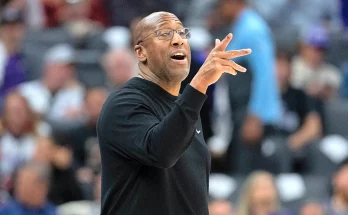The buzz surrounding Colston Loveland has steadily grown into a roar since the moment the Chicago Bears announced his selection in the 2025 NFL Draft. Hailed by some as one of the most complete tight end prospects to come out of college football in recent memory, Loveland is already inspiring dreams of a future tight end dynasty in the Windy City. For a franchise with a history defined more by bruising linebackers and tenacious defense than explosive offense, Loveland represents not only a potential star at a critical offensive position, but also a symbolic turning point in Chicago’s pursuit of sustained offensive excellence.
Loveland’s rise to this moment didn’t happen overnight. A native of Gooding, Idaho, he was lightly recruited early in his high school career before emerging as one of the most dynamic tight ends in the country. His blend of size, athleticism, hands, and football IQ made him a prized target for Michigan head coach Jim Harbaugh, and by the time he arrived in Ann Arbor, it was clear he had the potential to be special. At Michigan, Loveland blossomed into a game-changing threat. He became a key cog in the Wolverines’ offense, demonstrating not just the ability to make contested catches and stretch the field, but also a rare willingness to block with intensity and precision. His combination of traits drew comparisons to NFL greats, and it didn’t take long before scouts began projecting him as a first-round talent.
When the Bears made the call to bring Loveland to Chicago, the decision was met with widespread approval among analysts and fans alike. In a league where top-tier tight ends can redefine the identity of an entire offense—names like Travis Kelce, George Kittle, and Mark Andrews come to mind—teams are constantly searching for the next player who can serve as both a safety blanket and a matchup nightmare. For Bears fans, who have long yearned for a star-caliber tight end since the days of Greg Olsen and Mike Ditka, Loveland’s arrival felt like the first step toward something special.
What sets Loveland apart isn’t just his physical tools—though at 6-foot-5 and 245 pounds with 4.6 speed, those are undeniably impressive. It’s the way he sees the game. His ability to read defenses, adjust his routes on the fly, and find soft spots in coverage speaks to a maturity well beyond his years. He doesn’t just run routes; he understands leverage, timing, and the subtle art of manipulating defenders with his body and eyes. Quarterbacks love throwing to him not just because of his catch radius but because of his reliability. When a play breaks down, Loveland knows where to be.
But what’s perhaps most exciting for Chicago is how seamlessly Loveland fits into the team’s broader vision for the future. The Bears have already begun constructing an offense built to last, one that can support a young quarterback and keep pace in a high-scoring league. With dynamic playmakers at wide receiver and a retooled offensive line, adding a tight end like Loveland creates a three-level threat that forces defenses to pick their poison. Double the receivers, and Loveland will feast underneath. Stack the box, and he’ll leak out for chunk gains over the middle. And in the red zone, his size and hands make him an ideal target for jump balls and quick strikes.
Already in rookie mini-camp and early workouts, Loveland is turning heads. Coaches rave about his professionalism, his work ethic, and his ability to absorb the playbook at an accelerated pace. Teammates speak of his confidence—not arrogance, but a calm self-assuredness that suggests he knows he belongs. He has quickly built chemistry with the quarterbacks, and multiple reports out of Halas Hall suggest he could be featured prominently even in his rookie season.
For Bears fans, this feels like uncharted territory. The franchise has rarely had a dominant tight end presence that could tilt the field, and for years the position has been plagued by inconsistency, injury, and underperformance. While Cole Kmet remains a valuable contributor, the arrival of Loveland introduces the possibility of something more—a dual-tight end attack that can both block and attack downfield with equal efficiency. In an NFL increasingly embracing creative personnel groupings and mismatch football, having two capable tight ends who can stay on the field in any situation is an advantage few teams can boast.
What makes the situation even more enticing is the long-term potential. Loveland is just 21 years old, still growing into his frame, still refining his technique. If he continues to develop as expected, he could become the kind of player who redefines the tight end position in Chicago and sets a new standard for what’s expected at Halas Hall. His presence also elevates the entire offense. Wide receivers will have more space to operate, running backs will face lighter boxes, and quarterbacks will have that ever-valuable security blanket in high-pressure moments.
The comparison to elite tight ends is inevitable, and while it’s premature to anoint Loveland in the same breath as Kelce or Kittle, the foundation is there. Like Kittle, Loveland plays with a ferocious intensity that belies the finesse often associated with receiving tight ends. Like Kelce, he has a natural sense of space and timing that allows him to thrive even when defenses key on him. And like Andrews, he has a knack for coming through in the clutch. If he can maintain his health and continue developing, there’s every reason to believe he could be mentioned in that same elite tier within a few seasons.
Beyond his on-field potential, Loveland is also emerging as a fan favorite for his demeanor and humility. He speaks with the poise of a seasoned veteran, always crediting his teammates, coaches, and family for his success. He’s quick to mention the impact Michigan had on shaping him and is already embracing the culture and history of the Bears organization. For a blue-collar city like Chicago, where fans value grit, loyalty, and hard work, Loveland fits the mold perfectly.
There’s also something to be said about timing. The Bears are entering a new era, buoyed by a fresh wave of optimism and a front office that seems more competent and forward-thinking than at any point in recent memory. The team’s decisions in recent drafts and free agency have reflected a clear vision and a commitment to building through the draft. Adding Loveland to that puzzle isn’t just about filling a position—it’s about building an identity.
Fans have already begun dreaming. Social media is filled with highlights from his Michigan days, speculative depth charts, and bold predictions about future Pro Bowl appearances and All-Pro selections. Talk radio hosts are discussing whether the Bears finally have the pieces in place to support a Super Bowl run in the coming years. And throughout it all, Loveland has remained grounded, focused solely on getting better each day and earning the respect of his coaches and teammates.
Of course, the NFL is a league that humbles even the most promising prospects. There will be growing pains, adjustments, and lessons to be learned. But in Colston Loveland, the Bears have something they haven’t had in a long time—a tight end who doesn’t just fill a need but elevates the potential of the entire offense. Someone who can be the face of a position for a generation and perhaps even carry the torch for a new offensive dynasty in Chicago.
As summer gives way to training camp and the 2025 NFL season draws closer, all eyes will be on Halas Hall. There will be plenty of storylines, from quarterback play to defensive progression. But amid all the chatter, one storyline is quietly gaining momentum—the emergence of Colston Loveland, and the possibility that the Bears may have just unlocked a key to long-term success. It’s a rare feeling in Chicago, but one that’s unmistakable when it appears: hope. Real, tangible, justified hope. And this time, it comes in the form of a tight end who might just be destined to change everything.


